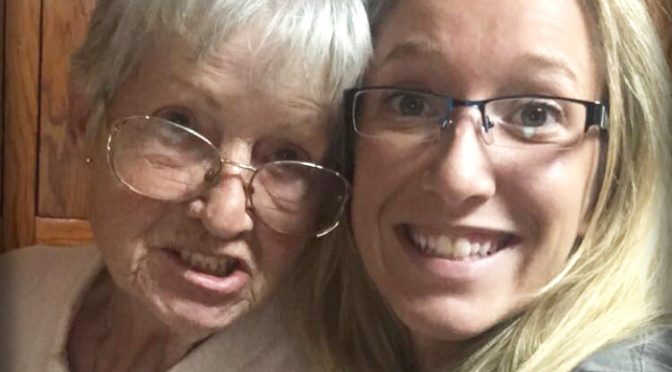Mary Cracraft is a third-semester nursing student at Newman University. During the 2016 Christmas break, she traveled to Blythdale, Mo., to spend time with her family. One night Cracraft felt a strong gut feeling to check up on her grandmother. The feeling was so strong she knew she could not ignore it.
When Cracraft arrived at her grandmother’s house, her grandmother, who Cracraft is named after, asked her granddaughter if she would feel an abnormality in her abdomen. “It feels like my heart is in my stomach,” the grandmother said.
In the nursing program, students are thoroughly taught how to assess a person to see if anything is out of the normal. Upon feeling the aortic pulsation, Cracraft deemed her grandmother had an abdominal aortic aneurysm due to the aortic vessel being nearly five centimeters in width, which is larger than it should be.
“I didn’t freak out,” said Cracraft. “I looked at the assessment document on my phone and it confirmed my suspicions.”
The aneurysm Cracraft found is an enlargement of the aorta which is the main artery that delivers blood throughout the body. When the aorta enlarges less blood is getting through to the rest of the body.
Before taking any further action, Cracraft e-mailed Associate Professor of Nursing Amy Siple, M.S.N. to seek advice on how to proceed. Within 20 minutes, Siple e-mailed back to say what Cracraft described sounded like an aortic aneurysm and she should take her grandmother to the emergency room.
A week prior to Cracraft’s arrival, her grandmother had visited the doctor because she had been passing out. The doctor did not perform an assessment on her grandmother but simply gave her higher blood pressure medication. Due to the assessment, Cracraft knew higher blood pressure medicine was not what her grandmother needed, but in fact, she needed surgery.
The nearest hospital they went to was a small local hospital that did not have an ER or the means necessary to provide the health care her grandmother needed. Cracraft, her mom, and grandmother met opposition from the nurses who flippantly dismissed Cracraft’s assessment. Thankfully a doctor overheard and ordered a Computed Tomography (CT) scan on the grandmother immediately. The doctor shortly returned with the results that confirmed Cracraft had in fact assessed her grandmother correctly, and in so doing had saved her grandmother’s life.

If they had not gone to the hospital there was a chance the aneurysm could have burst, thereby creating a slim chance of her grandmother living.
“Fifty percent of people who have an aortic aneurysm rupture on the way to the hospital stay alive, and 25 percent of those go through surgery,” Cracraft said. “Only 10 percent live.”
They rushed her grandmother by ambulance to Liberty Hospital near Kansas City, Mo.
The doctor at Liberty Hospital said he was impressed with Cracraft’s assessment skills.
“He asked what made me assess her there, because a lot of doctors don’t do head-to-toe assessments thoroughly,” Cracraft said the doctor told her.
“I heard a bruit [swishing of blood] and saw that the aortic vessel had expanded past the normal width, so I decided she needed to see a doctor,” Cracraft replied.
A long night of observation ensued as Cracraft and her mother waited for three hours into the morning of the next day. Early that morning Cracraft’s mother, who is the daughter of Cracraft’s grandmother, told her that this was the best birthday present – having her daughter save her grandmother’s life.
Her grandmother had surgery on Jan. 12, just a little more than 24 hours after the aneurysm was found.
Cracraft’s grandmother is recovering quickly and says she feels much better, and has the ability to breath much easier. During her grandmother’s recovery, Cracraft met the nurse who was taking care of her grandmother. The nurse happened to be a Newman graduate.
“It’s a small world having a Newman nurse taking care of my grandma,” Cracraft said.
As for the gut feeling she had, she gives credit to God, who she felt was working in the situation to compel her to check on her grandmother. She also is incredibly grateful to the outstanding training she has received in the nursing program, and especially to Siple, who took the time to reply to a student’s e-mail late at night on Christmas break.

“Professor Siple is an amazing role model, not just a teacher,” said Cracraft. “If it wasn’t for the assessment skills that she taught me through the rigorous program, my grandma may no longer be with us. The nursing program at Newman is exceptional because I was taught about life-saving things the associate nurses at the first hospital we visited didn’t understand.”
Cracraft later told her nursing peers about how she effectively used something from school.
“The professors are really providing the framework,” she said.
Since Cracraft’s grandmother’s recovery, “Everyone keeps saying I saved her life but I don’t see it that way. I don’t see myself as heroic because being a nurse is what I do.”
After graduation, Cracraft plans to move to Hawaii where her fiance will be stationed. She is currently looking at hospitals and making connections while finishing her final year of the nursing program.

